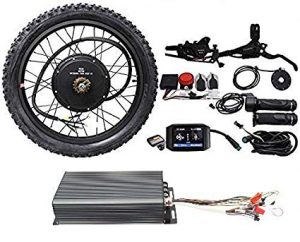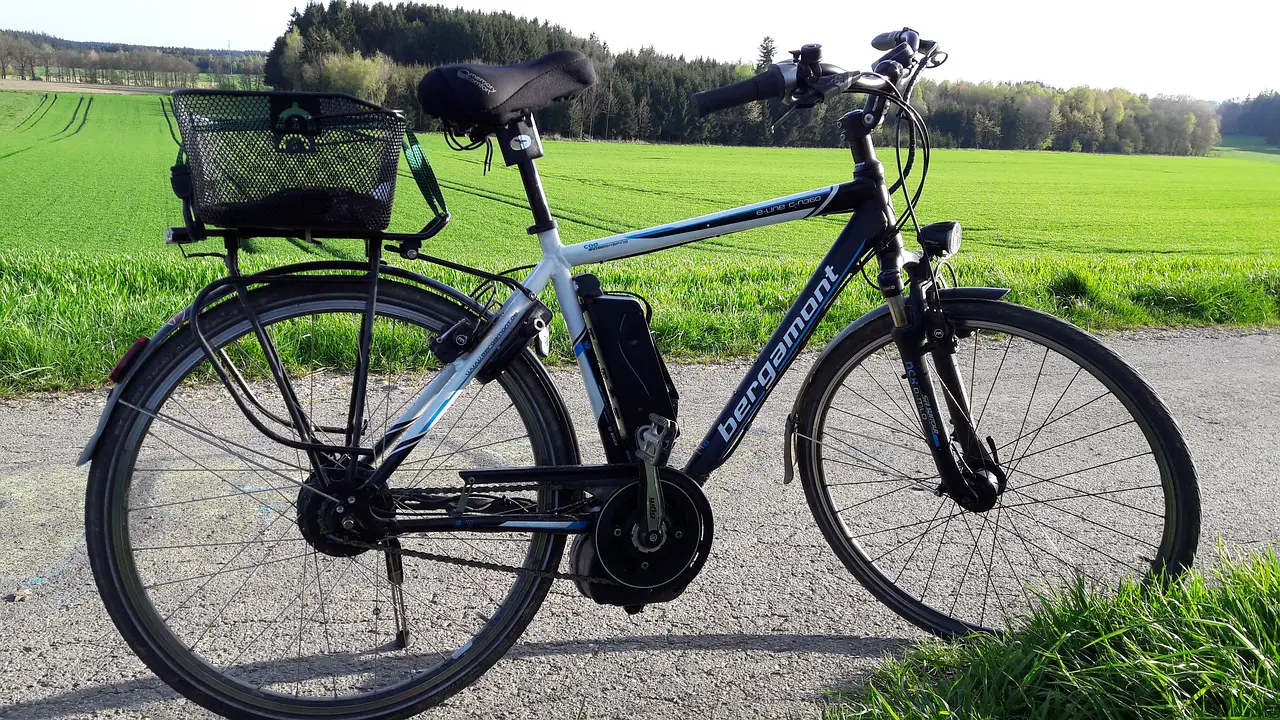In short, definitely yes.
There are more benefits than cons to own and ride an e-bike. And with the rapid advance of technology, they slowly become more and more accessible to everybody.
Why so. Join me through this thorough analysis of the pros and cons of owning an e-bike. An e-bike may or may not be right for you depending on your situation.
But first, what are e-bikes and how do they work?
E-bikes are like normal ones, with the addition of being equipped with an electric motor that aids the rider with the peddling and with the throttle. Those additions consist of a motor, a rechargeable battery, a drivetrain, a controller and occasionally, a pedaling sensor.
The process is a simple one: First, the battery powers the motor which then applies energy to the drivetrain. Afterward, the drivetrain applies torque and manual power to the wheels. The power that goes to the wheels is completely dependent on you. It can either go power only, no power or a combination of the two where you pedal while being assisted.
>>> Check out our article about the best electric scooter accessories here <<<
Where can you ride them? Is there any legislation regarding e-bikes?
Some countries/states allow you to ride them on bicycle lanes, while others not. There is also a difference between bike-lanes and bike-paths. The lanes are the marked road portions where you can usually ride an e-bike next to other vehicles. Bike-paths are usually prohibitive to motorized vehicles. However, some legislations exclude e-bikes from this category if the motor power doesn’t exceed a certain power. (source)
As for legislation regarding E-bikes varies considerably from country to country. While some countries lack legislation concerning e-bikes, some countries regulate them with pin-point precision.
In the United States, for example, each state has its own laws regarding e-bikes. However, at a federal level, they are considered consumer products that must not exceed a certain motor power.
Same with the EU and other developed countries.
For specific information regarding e-bike legislation around the world, check this Wikipedia page.
What are the pros?
They are easy to use and maintain
Their main attraction is that they are, at their core, mere bikes. So they are as easy to use as any other simple bike. Plus, other than the motor, battery and adjacent gear, the process consists of basic bike maintenance. Which, depending on the bike itself, can either be cheap, moderately priced or expensive.
They can also be ridden in wet/rainy conditions without much hustle. However, be sure to keep your battery protected. They cost hundreds of dollars, according to quality and manufacturer.
The battery is, without doubt, the most expensive consumable of an electric bike. With the latest advances in battery tech however they should be able to handle about 500-1000 charge cycles or 2-3 good years.
They combine the best of all worlds
The second reason why people choose e-bikes over other transportation methods is that they combine the best of all worlds. Let me explain what I mean by this:
First of all, it is a bike, which means that, unlike e-scooters and cars, you actually apply effort in pedaling. This, next to all of its environmentally friendly consequences, means that you are actually exercising.
Sure, it is not the same as a full-on bike, but there is effort and you are going to gain some benefits. Those include, among many others:
- improved blood sugar levels
- lower-fat ratios
- a better cardiovascular function
Secondly, it is an electric bike, which does not require fossil fuel for movement. Just some sweet, cheap and renewable electric juice and then you are good to go. Furthermore, if your battery fails, it will still function as a normal bike.
Their third benefit is their overall convenience. It is light, silent, fast, easy to park and hold, cheap to maintain and requires no insurance or permit to ride. A true jack of all trades.
Furthermore, they take relatively few hours to charge (2-5, depending on battery quality and age). However, this is simply mitigated by charging them during sleep time or while at work.
They are convertible
You heard me right. With a bit of tinkering and with the necessary tools, you may convert a normal bike into an e-bike. It won’t run as well as a factory-made one, but you may thus avoid the incredibly steep price. You may even use this occasion as a “demo” version of the real thing. Thus, you may find out whether you would like to put money into an expensive e-bike.
Basic conversions are ”relatively” cheap. Don’t believe me? Then check this conversion kit (link to Amazon).

They are rider-friendly
They are a great help to people who want to bike around but lack the strength and fortitude to do so. This includes the elderly, who have left their prime year behind them. This is especially true if said people live in hilly or mountainous areas with steep slopes that need climbing. As long as you can put in some pedal to the metal, the motor will do the rest for you.
Furthermore, the down-tube battery enhances the balance of the bike by giving it a solid anchor. This is especially favorable to the aforementioned people who would normally struggle with maintaining balance and putting in the effort.
They are environmentally friendly
Definitely. While cars emit, on average, almost two tons of CO2 yearly, e-bikes produce basically nothing. They are motion driven and battery-assisted. Sure, they can pollute by having their batteries thrown in a garbage field, but that is not the bike’s doing. Those batteries have also been designed to last a few good years before failing, requiring only a source of energy.
Plus, when is the last time you heard that bikes are responsible for damaging roads and costly environmentally-damaging situations? Exactly, there isn’t one. Being basically bikes, they are silent, light and do not require as much infrastructure to function. You won’t need a 3 lane highway, a huge parking lot and a lot of fuel and pollution to operate an e-bike. On the contrary, you only need a small bike lane, a full battery, a lock, and a sunny, clear sky.
They make life easier
If you consider buying an e-bike, it means that you are most likely sick of all that annoying traffic. Especially the “peak hour” type of traffic where 40 minutes by car can be made at the same time on foot. Or that you simply want to exercise more, but without too many physical implications.
Well, e-bikes, are not only slim but are way faster than their siblings. This is why they will allow you to basically skip any traffic and reach your destination mostly unhindered and completely stress-free.
Another strong, yet obvious, the point is that they enhance your speed by an incredibly high margin. This will lead to an overall faster ride and less time spent on the road.
What are the cons?
First of all, they are a jack of all trades. In no way, you will benefit from either extreme. To be more specific, despite having a motor to assist you, you cannot expect it to pull you all by itself. It wasn’t meant for this. That is what scooters are for. The motor is there only to give you a considerable push, so you will still need to pedal.
If you bought one hoping that you can cheat all that effort while still working out, then you have wasted your money. You can do some cardio/lose some weight, but the results are minimal since while the bike is in motion, most of the heavy lifting will be done by the motor and inertia.
Price
Another disadvantage is that they come at double the price of a normal bike. A normal, entry to mid-level e-bike will usually come at a price tag of between 1,000$ and 2,000$. Prices can also go up to 4,000$ for the more fancy and powerful models. Also, good e-bike batteries usually cost you about a third of the entire bike.
You will also have to consider stuff like regular maintenance and specialized maintenance when the situation arises. And since e-bikes aren’t found at every corner, parts, and services might be hard to come by and expensive.
Weight
Furthermore, they are heavy. Their average weight is about 45lbs/20kg, going as far up as 100lbs/45kg. If the battery runs dry, then you are stuck with riding it the normal way. In comparison, an average bike weighs about 29lbs/13kg.
Battery life and power
Which leads us to one of their greatest fails – their battery life. On average, their mileage per charge will go up to 36 miles/50 km. And this will gradually fall through constant usage and depending on its rider’s weight. This is fine for commuting only, but you are thus confined to a limited area. Quality, which means expensive, Li-ion batteries, however, takes only 2-6 hours to charge. Also, most e-bike chargers aren’t water-resistant, so avoid charging your e-bike outside.
Also, regarding performance, do not take their weight for granted. They may be heavy, but they are incredibly fast. While the average speed of a normal bike rider is that of 15 miles/h or 24 km/h, theirs is approximately doubled. This means that someone with slow reflexes will probably be as much a threat to others as with himself/herself. Although most countries limit the speed at 20-25 miles/h or 32/40 km/h, some people choose to just go fast regardless.
Additionally, when it comes to battery power, low temperatures will severely hinder your experience. They, on average, temporarily reduce the battery capacity by a margin of 10-20%. As for the cold itself, the major disadvantage is that there is no heating system on a bike. Thus, you will be freezing your face off.
Efficiency
Furthermore, on the issue of energy, very few e-bikes include a system that converts the action of pedaling and braking into energy. The present technology isn’t advanced enough to mass-produce it cheaply. So, until more reliable, super batteries will be invented, you will be stuck with charging it day and night while not in use.
How long do they last?
Batteries
On average, the batteries will typically last for about 1000 charging cycles or somewhere between 3-5 years of repeated charging. At this point, expect the battery to be significantly weaker with each recharge. Also, keep in mind that we are talking here about lithium batteries, which are the most commonly used with e-bikes.
Motors
They are, by far, the most durable components of an e-bike. Their life cycle cannot be pinpointed, as they will last for as long as you keep them well maintained. Thus, regular and proper care will significantly elongate the life of any motor, regardless of brand.
Tires
Depending on their quality and everyday use, expect them to last for about 1000 to 3000 miles or 1600 to 4800 km. keep in mind that by “everyday use” I also refer to the quality of the road. The more you avoid off-roads or pothole infested roads, the longer your tires will be able to be used.
Brakes
This is the most complicated one of this list. The lifeblood of any brakes depends on a multitude of factors, such as:
- weather conditions;
- humidity;
- riding style (aggressive with quick braking, long and short braking);
- surroundings (for example, if you descent on a lot of slopes or live in a crowded city, where you require a lot of braking);
- quality of components;
Well, depending on those variables, and with good quality rim brakes, you should be good for about 3,000-5,000 km or 1,900-3,100 miles. Good quality disk brakes take it even further, at about 6,000 miles or 9,700 km.
Chains and sprockets
The lifeblood of those components greatly depends on humidity, wear and tear, how often you oil it and so on. Thus, the chain should be, on average, changed with every 2,000-3,000 miles or 3,200-4,800 km. The sprockets should, on average, last at least three times more than the chain.
Replacement costs (on average)
- Battery – 700$-900$
- Handlebar-mounted head unit and attachment collar – 90$
- All-weather drive rollers – 35$
- Drive belt – 30$
- Drive belt cover – 28$
- Standard attachment brackets – 26$
- Pedal-assist sensor – 25$
- Rubber bumper strips for chassis – 25$
- Miscellaneous screws and small parts – 5$-12$
Are e-bikes worth your money?
They are worth you every penny. At first, you might be inclined to cringe at their price point. However, once you take into consideration their added value and long term, you will find out that they are worth it.
Let us take a 3-year example to calculate their value. E-bikes, despite being so expensive initially, pale in comparison to cars or even public transportation. Cars require everything from fuel, insurance, parking costs, repairs, stress, and many others. Public transportation, despite being cheap per ticket, will add up considerably over those years. Should you treat your bike right, the yearly maintenance costs should be around 200$. This includes tuning up (70-100$), flat tire fixes (10-20$), brake adjustments (20-35$) and drivetrain replacements (20-60$).
This is taken in addition to the average costs of about 0.75 to 4 cents/12 miles, depending on local electricity prices. Thus, for an average of 12 miles to work, you get 3.6$ per 24 miles or 1,239.75$ per year. For more numbers, check this link. A car, on the other hand, costs you, on average, 8,500-10,500$ for a middle-sized car at an average of 13.000 miles/American driver per year. Furthermore, expect even higher prices for trucks and other such vehicles.
As for how much an e-bike saves you, we have the following table to compare the aforementioned numbers with:

Thus, you can see that when broken down, a medium car will cost more than 320$ monthly, when an e-bike will cost that per year.
Furthermore, an e-bike, after 3 years, will not only save you considerable amounts of money in the long term but will also enhance your physical condition. Sure, it’s not like a pure-bike, but it is something and all for less of a hustle. Cars and public transportation encourage obesity, not vice-versa.
What is the suitable distance to work to consider buying an e-bike?
On average, an e-bike has a 50 mile/80km mileage per charge. Thus, you can go up to twice of 18-24 miles 30-40 km distances per commute with ease. Or, you can go a full mileage if you can charge in at work.
Are there any foldable e-bikes that you can put under your desk office?
Well of course! This bad boy (link to Amazon) is the first that comes to mind. And quite a steal for its price.
What are the best seasons to ride e-bikes?
E-bikes can be ridden throughout most of the year. Even during winter! (source) Although, during winter, you should take off the battery and charge/deposit it at room temperature. If not, it will lose its capacity. Furthermore, spiked wheels are permitted with e-bikes, but only for pedelecs assisted of up to 15 miles/h or 25 km/h.
As for rainy weather, you can use them, but in a limited fashion.(source) E-bikes are water-resistant, but not water-proof. Short-term exposure shouldn’t be an issue, yet long-term exposure will, in time, damage your electric components. Cover them whenever you can and avoid submerging them in water. Whatever the manufacturer says, no bike is entirely water-proof.
Here are the annual average weather charts for the US. (source)


Conclusion
In conclusion, we can easily say that they are beyond worth it, as the benefits far outweigh the cons. E-bikes combine great features of many ways of transportation while mitigating most of their flaws. Sure, they do come with their flaws, but nothing ever comes out perfect.
They offer great value for their price in the long run. They offer a smooth, quick and reliable method of commuting/transportation, while allowing for some physical exercise. As jack of all trades, e-bikes are definitely worth it.
>>> BEFORE YOU GO! Check out our article about the best electric scooter accessories here <<<
